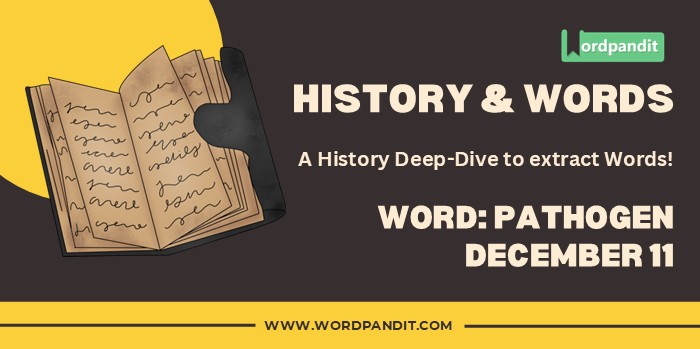History & Words: ‘Pathogen’ (December 11)
Welcome to ‘History & Words.’ 🌟 I’m Prashant, founder of Wordpandit and the Learning Inc. Network. This series combines my passion for language learning with historical context. Each entry explores a word’s significance on a specific date, enhancing vocabulary while deepening understanding of history. Join me in this journey of words through time.
📚 Table of Contents
🔍 Word of the Day: Pathogen
Pronunciation: /ˈpæθədʒən/ (PATH-uh-jen)
🌍 Introduction
On December 11, 1922, the medical world witnessed a transformative moment when researchers at the University of Toronto successfully administered insulin to a human patient with diabetes. This breakthrough not only revolutionized diabetes treatment but also deepened our understanding of how pathogens and metabolic diseases affect human health.
The word “pathogen” stands at the intersection of medical science and human health, representing microorganisms that can cause disease. From bacteria and viruses to fungi and parasites, pathogens have shaped human history through epidemics, medical discoveries, and the constant evolution of healthcare practices.
🌱 Etymology
The term “pathogen” combines two Greek roots: “pathos” meaning suffering or disease, and “gen” meaning to produce or create. Literally translated as “disease-producer”, the word emerged in the late 19th century during the golden age of microbiology, when scientists like Louis Pasteur and Robert Koch were establishing the germ theory of disease.
📖 Key Vocabulary
- 🔑 Virulence: The severity or harmfulness of a pathogen or disease
- 🔑 Host: An organism that harbors a pathogen under natural conditions
- 🔑 Infectious Disease: An illness caused by a pathogen that can be transmitted between organisms
- 🔑 Immunity: The body’s ability to resist or fight off pathogens and their harmful effects
- 🔑 Vector: An organism that transmits a pathogen to another organism
🏛️ Historical Context
The understanding of pathogens has evolved dramatically throughout human history. Ancient civilizations, while unaware of microorganisms, recognized patterns of disease transmission and developed basic hygiene practices. The ancient Greeks, Romans, and various Asian civilizations documented the spread of diseases and developed early theories about their causes.
The scientific revolution of the 17th century brought new tools like the microscope, enabling the first observations of microorganisms. However, it wasn’t until the 19th century that the connection between microorganisms and disease was firmly established through the work of pioneers in microbiology.
The development of germ theory in the late 1800s represented a paradigm shift in medicine, leading to revolutionary changes in medical practices, public health measures, and the development of vaccines and antibiotics.
⏳ Timeline
- 1674: Antoni van Leeuwenhoek observes bacteria through his microscope
- 1854: John Snow traces cholera outbreak to contaminated water pump
- 1861: Louis Pasteur publishes his germ theory of disease
- 1882: Robert Koch identifies the tuberculosis bacterium
- 1892: Dmitri Ivanovsky discovers viruses
- 1922: First successful insulin administration to a human patient
- 1928: Alexander Fleming discovers penicillin
- 1967: WHO launches Global Smallpox Eradication Program
🌟 The Day’s Significance
December 11, 1922, marks a pivotal moment in medical history when Frederick Banting and Charles Best, working at the University of Toronto, successfully treated their first human patient with insulin. This breakthrough came after months of research and experiments with diabetic dogs, demonstrating how understanding metabolic diseases was as crucial as fighting pathogens.
The success of insulin therapy represented a new frontier in medicine – the ability to treat diseases caused not by pathogens, but by the body’s own metabolic dysfunction. This distinction helped establish our modern understanding that disease can arise from various sources, not just infectious agents.
The development of insulin therapy also exemplified the scientific method’s power in medical research, establishing protocols that would later be used in studying pathogen-related diseases and developing treatments.
💬 Quote
“In the fields of observation, chance favors only the prepared mind.” – Louis Pasteur, pioneer of germ theory and microbiology
🔮 Modern Usage and Reflection
Today, “pathogen” remains a critical term in medical science, particularly relevant in an era of emerging infectious diseases and global pandemics. The study of pathogens has expanded to include understanding genetic factors, environmental influences, and the complex interactions between microorganisms and human hosts.
🏛️ Legacy
The scientific understanding of pathogens has led to numerous medical advances, from vaccines and antibiotics to modern sanitation practices. This knowledge continues to evolve as we face new challenges like antibiotic resistance and emerging infectious diseases.
🔍 Comparative Analysis
While early understanding of pathogens focused primarily on their harmful effects, modern science recognizes a more nuanced relationship between microorganisms and human health, including the beneficial roles of many microbes in the human microbiome.
💡 Did You Know?
🎓 Conclusion
The history of understanding pathogens reflects humanity’s ongoing struggle to comprehend and combat disease. From the microscope to modern genetic sequencing, each advancement has deepened our knowledge while revealing new complexities in the relationship between pathogens and human health.
📚 Further Reading
- 📘 “The Ghost Map: The Story of London’s Most Terrifying Epidemic” by Steven Johnson
- 📗 “The Emperor of All Maladies: A Biography of Cancer” by Siddhartha Mukherjee
- 📙 “Microbe Hunters” by Paul de Kruif












